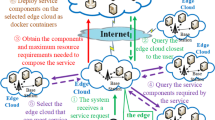Abstract
At present, the search content and results of common multimedia search engines have gradually failed to meet the personalized search requirements of users. The paper focuses on personalized cloud search engines for multimedia. First, the binary ant colony algorithm is optimized by the cloud model. Then, the binary ant colony algorithm is used to improve the multimedia search engine. Detailedly, a binary directed graph for ant colony traversal is designed in which each ant traverses its own path, and the solution traverses by each ant is integrated to solve the problem. Experiments show that the proposed method effectively improves the query speed of personalized multimedia search engines, reduces redundant information, and improves the user search experience.





Similar content being viewed by others
References
Arasu A, Cho J, Garcia-Molina H et al (2001) Searching the web[J]. ACM Trans Internet Technol (TOIT) 1(1):2–43
Bouhana A, Zidi A, Fekih A, Chabchoub H, Abed M (2015) An ontology-based CBR approach for personalized itinerary search systems for sustainable urban freight transport. Expert Syst Appl 42(7)
Chen L, Scare K (1998) Web mate a personal agent for browsing and searching. Proceedings of the 2nd international conference on autonomous agent
China Internet Information Center. The 31st Statistical Report on the Development of China's Internet.http://www.cnnic.net.cn/hlwfzyj/hlwxzbg/hlwtjbg/201808/t20180820_70488.htm
Chuang C, Wei Z, Zhifu W, Zhi L (2017) The diagnosis method of Stator winding faults in PMSMs based on SOM neural networks. Energy Procedia 105
Egghe L (2008) Mathematical theory of the h- and g-index in case of fractional counting of authorship. J Am Soc Inf Sci Technol 59:1608–1616
Li Li. Research on personalized information service retrieval model of digital library based on multi-agent technology. Inform Sci, 2018,36(05):90–93+9
Liu S, Lu M, Liu G (2017) A novel distance metric: generalized relative entropy. Entropy 19(6):269
Liu G, Liu S, Muhammad K et al (2018) Object tracking in vary lighting conditions for fog based intelligent surveillance of public spaces. IEEE Access 6(1):29283–29296
Liu S, Bai W, Liu G et al (2018) Parallel fractal compression method for big video data. Complexity 2018:2016976
Liu S, Zhang Z, Qi L et al A fractal image encoding method based on statistical loss used in agricultural image compression. Multimed Tools Appl 75(23):15525–15536
Madhavan J, Ko D, Kot L, Ganapathy V, Rasmussen A, Halevy A (2008) Google’s deep-web crawl. PVLDB 1(2):1241–1252
Nápoles G, Mosquera C, Falcon R, Grau I, Bello R, Vanhoof K (2018) Fuzzy-rough cognitive networks. Neural Netw,,97
Ren S, He K, Girshick R et al (2017) Faster R-CNN: towards real-time object detection with region proposal networks. IEEE Trans Pattern Anal Mach Intell 39(6):1137
S. Insight (2017) Search engine statistics. http://wwwsmartinsightscom/search-engine-marketing/search-engine-statistics/
S.E.J (2016) Search engines gain in daily usage. https://www.searchenginejournal.com/search-engines-gain-in-daily-usage/2545/
Schreiber M (2009) A case study of the modified Hirsch hmaccounting for multiple coauthors. J Am Soc Inf Sci Technol 60(6):1274–1282
Vahid J, Reza MBM (2010) A unified architecture for biomedical search engines based on semantic web technologies. J Med Syst 35(2)
Wan Y, Wang M, Ye Z et al (2016) A feature selection method based on modified binary coded ant colony optimization algorithm. Appl Soft Comput 49:248–258
Wang Z (2011) Application of cloud theory in association rules. Int J Inform Technol Comput Sci 3:36–42
Wang S, Li D, Shi W et al (2003) Cloud model-based spatial data mining. Geograph Inform Sci 9(1–2):60–70
Wang G, Xu C, Zhang Q et al (2012) A multi-step backward cloud generator algorithm //international conference on rough sets and current trends in computing. Springer, Berlin, Heidelberg, pp 313–322
Wang G, Xu C, Li D (2014) Generic normal cloud model. Inf Sci 280:1–15
Xiong W, Wang L, Yan C (2006) Binary ant colony evolutionary algorithm. Int J Inf Technol 12(3):10–20
Yang L, Zhang R, Hou T et al (2016) Hesitant cloud model and its application in the risk assessment of “the twenty-first century maritime silk road”. Math Probl Eng 2016:5620803
Yao H, Yang H, Zhang A, Fang C, Guo Y (2017) WLAN interference self-optimization using som neural networks[J]. Concurr Comput: Pract Exper 29(3)
Zhang R (2013) Improvement of personalized search engine based on multi-information ant Colony algorithm [D]. Guangzhou, Jinan University, :13–24
Zheng P, Shuai L, Arun Kumar S et al (2018) Visual attention feature (VAF) : a novel strategy for visual tracking based on cloud platform in intelligent surveillance systems. J Parallel Distrib Comput 120:182–194
Acknowledgements
This paper is funded by following projects: National Natural Science Foundation of China (No. 7156303, No. 61741509); Project of Inner Mongolia Educational Department (NJZY015).
Author information
Authors and Affiliations
Corresponding author
Additional information
Publisher’s note
Springer Nature remains neutral with regard to jurisdictional claims in published maps and institutional affiliations.
Rights and permissions
About this article
Cite this article
Jin, T., Wang, H. & Li, Z.(. A personalized cloud engine for multimedia search based on binary ant colony algorithm. Multimed Tools Appl 79, 16487–16499 (2020). https://doi.org/10.1007/s11042-019-7372-3
Received:
Revised:
Accepted:
Published:
Issue Date:
DOI: https://doi.org/10.1007/s11042-019-7372-3




